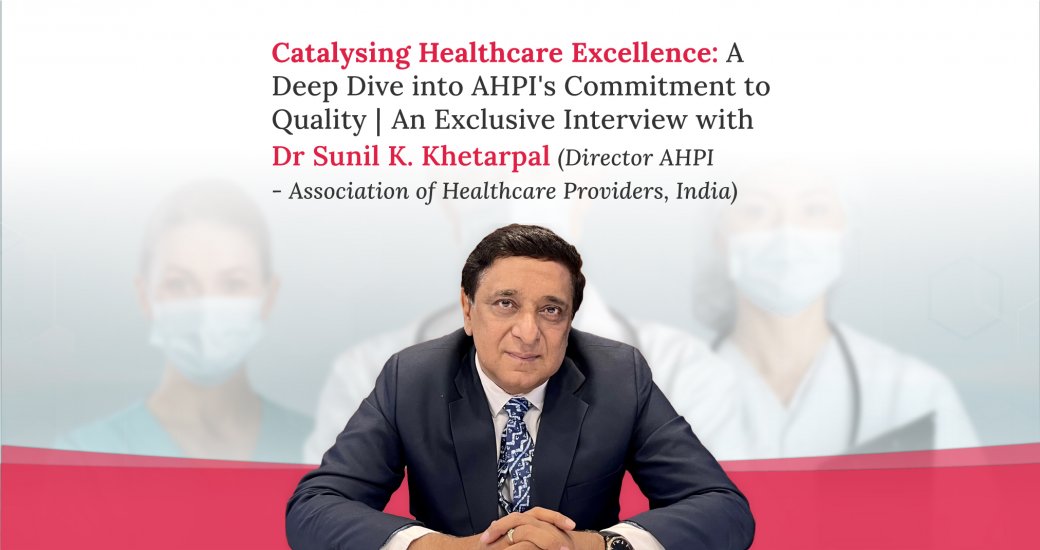
Discover the future of healthcare in India with AHPI's Director, Dr. Sunil K. Khetarpal. Gain insights on innovation, digital health, and leadership's role in continuous improvement in this celebration of our health newspaper's first anniversary.
In the dynamic and ever-evolving landscape of healthcare, the pursuit of quality stands as an unwavering commitment, shaping the experiences of patients and the effectiveness of healthcare services. As we celebrate the first anniversary of our health newspaper, we had the privilege of interviewing the Director of the Association of Healthcare Providers India (AHPI), Dr. Sunil K. Khetarpal, a stalwart in the realm of healthcare quality. In this enlightening conversation, Dr Khetarpal shares insights into AHPI's initiatives, the significance of Quality Month, and the pivotal role leadership plays in fostering a culture of continuous improvement. Join us as we delve into the strategies, innovations, and collaborative efforts that define AHPI's vision for the future of healthcare quality in India.
In the context of healthcare, what does 'quality' mean, and how does AHPI promote and celebrate it during Quality Month?
In the realm of healthcare, 'quality' refers to the extent to which health services contribute to achieving desired health outcomes for individuals and populations while aligning with current professional knowledge. The Association of Healthcare Providers (AHPI), which represents a significant number of private institutions in the country, actively promotes and celebrates quality during its designated Quality Month.
AHPI utilizes Quality Month as an opportunity to advocate for policies supporting healthcare quality improvement. Throughout this period, AHPI facilitates its member hospitals to engage in various initiatives including workshops, webinars, seminars, and training sessions, aimed at educating healthcare providers and patients on methodologies for enhancing quality. These forums serve as platforms for sharing best practices and insights related to quality improvement in healthcare Those who have excelled in championing quality are recognized and rewarded by the organizations during this dedicated month.
Can you explain what Quality Month is and why it is significant for healthcare providers and the general public?
Quality Month, internationally observed in November, is a dedicated period to celebrate and emphasize continuous quality improvement in various sectors.
For healthcare providers, Quality Month serves as a valuable opportunity for professional development. It provides a platform for sharing experiences and best practices while offering recognition for their efforts and achievements in the realm of quality improvement. This period fosters a collaborative environment where healthcare professionals can enhance their commitment to delivering high-quality care.
Beyond the healthcare industry, Quality Month holds importance for the general public. It plays a crucial role in raising awareness, enhancing communication with healthcare providers, empowering individuals, and promoting engagement in matters related to health, well-being, and safety.
Can you elaborate on the impact of AHPI awards in improving and maintaining quality standards in hospitals? Additionally, do these awards effectively educate patients about what to expect from a healthcare organization?
Certainly, the AHPI Healthcare Excellence Awards have proven to be instrumental in enhancing and sustaining quality standards within hospitals. We approach the 10th edition of these awards in February 2024, during AHPI Global Conclave 11.0 in Gandhinagar, Gujarat. With eight distinct categories of awards, each accompanied by well-defined criteria and an evaluation process, the Awards hold significant value and serve as a powerful impetus for hospitals to advance their quality journey. This multifaceted recognition not only acknowledges existing high standards but also serves as a reinforcement mechanism for continuous quality improvement, ultimately influencing and enhancing the overall patient experience.
Are there any innovative approaches or technologies being emphasized during Quality Month to enhance healthcare quality?
During Quality Month, AHPI (Association of Healthcare Providers) places a strong emphasis on innovative approaches and technologies to enhance healthcare quality. The organization actively supports technological innovations and encourages the adoption of digital health practices among its member hospitals in collaboration with its Technology partners in Digital Health and Medtech who are also our associate members.
The digital health ecosystem advocated by AHPI encompasses various elements, including the implementation of electronic medical records, patient portals, software solutions, and mobile health applications. Other domains of digital health include augmented reality, virtual reality, and telehealth apart from the domains including wearable devices, remote monitoring, IOTs, and point-of-care devices. These digital tools and platforms are used to improve access, efficiency, quality and safety and finally to improve healthcare outcomes. The use of digital health also lowers the cost of healthcare. Artificial Intelligence (AI) plays a pivotal role, with the understanding that AI is not intended to replace human doctors but to enhance their capabilities. The sentiment is clear – doctors embracing AI are better positioned in the evolving landscape of healthcare and will replace doctors who are not open to embracing digital health.
AHPI collaborates closely with the National Health Authority to actively promote the use of ABDM by distribution and display of IEC materials in healthcare facilities, and extend knowledge support by conducting sessions, and webinars for various programs like registering in a Health Facility Registry (HFR), creation of Ayushman Bharat Health Account (ABHA) for new patients and use of ABDM enabled digital solutions by different categories of hospital staff. Apart from this AHPI extends support in facilitating the onboarding of NHA’s flagship programmes viz. AB PMJAY and ABDM by the hospitals.
AHPI launched its first book on technology titled "The Future of Healthcare: Transforming with Technology" this year, available for free download on Amazon. This initiative underscores the organization's commitment to keeping its member hospitals informed and equipped with the latest advancements in technological innovations in healthcare.
In a post-pandemic era, digital health has become integral and transformative, serving as a game-changer in healthcare practices. AHPI emphasizes the importance of staying updated on these technologies, recognizing them not just as tools but as a fundamental aspect of the healthcare ecosystem.
How does AHPI collaborate with healthcare professionals, institutions, and the government to ensure continuous improvement in the quality of healthcare services?
AHPI actively collaborates with healthcare institutions to establish and promote accreditation programs, notably the National Accreditation Board for Hospitals & Healthcare Providers (NABH). Additionally, AHPI engages in advocacy efforts, working closely with government agencies and accreditation boards to influence policies related to healthcare quality.
Within the realm of accreditation and quality monitoring, AHPI plays a crucial role in various high-level committees. The organization is a key participant in the Quality Steering Committee established by the National Health Authority, overseeing the monitoring and rating of hospitals affiliated with the Pradhan Mantri Jan Arogya Yojana (PMJAY). AHPI is also involved in committees constituted by NABH for the grading of hospitals.
Further extending its collaborative efforts, AHPI is an integral part of the steering committee of the National Federation of Engineers for Electrical Safety (NFE) to promote Electrical Safety Audit through training, education, and skill development in electrical safety and reliability of electrical and biomedical installations in hospitals and medical locations by implementation of National Electrical Code of India 2023. AHPI’s joint initiatives with the Institute of Fire Engineers (IFE) have developed a Fire Safety Inspection Scheme with defined criteria and aims to ensure that requirements for fire safety for institutional buildings as per fire and life safety standards laid down in the National Building Code 2016 (NBC) are met. AHPI-AMTZ-AiMED has jointly launched Biomedical Equipment Maintenance Certification (BEMC) and the healthcare Textile Processing Facility Certification Scheme (HEALTEXPROF) which aims to ensure best practices for medical equipment maintenance and healthcare textile laundry processes in hospitals.
Emphasizing its commitment to training and education, AHPI leverages its expertise to organize training sessions on accreditation standards. Workshops and conferences are conducted to enhance skills, share best practices, and keep healthcare professionals updated on the latest developments in healthcare quality. Through these multifaceted collaborations and educational initiatives, AHPI plays a pivotal role in advancing and promoting high standards of quality in the healthcare sector.
For someone unfamiliar with the healthcare industry, what are the key aspects of quality in healthcare that they should be aware of?
Ensuring Patient Safety: Above all, the primary concern is safety. Individuals expect a healthcare environment that prioritizes their well-being, providing a secure setting where they can confidently receive medical attention
Effectiveness of Care: Quality healthcare involves the provision of evidence-based and effective medical treatments and interventions. The goal is to achieve desired health outcomes, ensuring that the care provided is impactful and aligned with established medical practices.
Patient-Centric Care: Visitors to a hospital anticipate healthcare providers who are sensitive to their needs and meet or exceed their expectations. Patient-centric care involves tailoring medical services to individual preferences, respecting values, and prioritizing effective communication, decision-making, and privacy.
Timeliness of Care: Prompt access to healthcare services is crucial. Patients value timely treatment without enduring unnecessary delays. Efficient processes in outpatient departments (OPDs), diagnostics, and in-patient departments (IPDs) contribute to positive patient outcomes and experiences.
Efficiency: Wisely utilizing resources and minimizing unnecessary waste or redundancy is a key aspect of healthcare quality. Efficiency not only contributes to effective care but also enhances cost-effectiveness in the delivery of medical services.
Equity: Regardless of differences in religion, caste, or gender, healthcare should be accessible and available to all individuals. Quality healthcare ensures equity, providing fair and unbiased care to everyone.
These six key aspects collectively form the foundation of healthcare quality that the general public should be aware of and expect from a hospital. Patient awareness is crucial, prompting hospitals to not only meet but strive to exceed these expectations. By prioritizing these elements, healthcare providers can enhance the overall quality of care and foster a positive relationship with the communities they serve.
What role does patient feedback play in assessing and improving the quality of healthcare services, and how can individuals contribute their feedback?
Healthcare quality encompasses medical as well as service excellence. Feedback in healthcare serves as a valuable tool, encompassing both positive and negative insights, comments, or suggestions. It extends beyond complaints and plays a pivotal role in shaping and enhancing the services provided by healthcare organizations.
Encouraging a culture of feedback is crucial for organizations seeking continuous improvement in their services. Patient feedback, in particular, serves as a dynamic measure of satisfaction at various touchpoints within the healthcare journey, spanning from parking facilities to entrance, registration, emergency services, outpatient departments (OPDs), diagnostics, and inpatient departments (IPDs). Patients desire satisfaction at every level, and feedback becomes a means to gauge and address their experiences.
Key Roles of Patient Feedback
Areas for Improvement: Patient feedback is instrumental in pinpointing areas that require enhancement, be it unruly staff behavior, excessive waiting times, or lapses in communication. It provides organizations with actionable insights to refine their services.
Enhancing Communication and Information Exchange: Feedback fosters improved communication between healthcare providers and patients. This exchange of information contributes to patient-centric care and helps prevent or minimize errors in the delivery of healthcare services.
Promoting Patient-Centric Care: Understanding patient perspectives through feedback promotes a patient-centric approach. It enables healthcare providers to tailor their services to meet the specific needs and expectations of individuals seeking medical care.
Building Trust and Confidence: A robust feedback system establishes trust and confidence among patients and their families. Knowing that their opinions are valued and acted upon creates a sense of transparency and accountability within the healthcare provider-patient relationship.
Supporting Continuous Quality Improvement: Feedback is integral to the cycle of continuous quality improvement. Hospitals should establish a systematic feedback mechanism involving the collection of feedback forms, thorough analysis, and the implementation of appropriate corrective and preventive actions.
Crucially, effective feedback mechanisms involve closing the loop by communicating the actions taken based on the feedback to the patients and their families. This transparency completes the feedback cycle and reinforces the commitment to ongoing improvement and increase patient satisfaction levels.
How do the organizations educate and engage with the patients and their families to promote a better understanding of quality standards?
Patient education, engagement, and empowerment are crucial components in healthcare, ensuring that patients and their families are well-informed about their healthcare needs, enabling them to make informed decisions, and actively involving them in care planning. Healthcare organizations employ various strategies to achieve these goals.
Information Displays: Healthcare organizations should prominently display information about their scope of services, patient rights, and responsibilities. Additionally, patient education materials in the form of brochures, pamphlets, and booklets explaining quality standards should be readily available.
Online Resources: Websites and portals play a vital role in providing access to educational resources. Online platforms can host a variety of materials, enhancing health literacy and ensuring patients understand medical information.
Health Literacy Programs: Implementing health literacy programs is essential for improving patient understanding of medical information. Workshops, webinars, and educational sessions on topics such as medication management and preventive care contribute to overall health awareness.
Preventive Care Focus: While curative care is vital, a holistic approach to healthcare includes preventive, promotive, curative, rehabilitative, and palliative care. Emphasizing preventive care through educational initiatives is critical.
Patient Education in Hospitals: Within hospital settings, using visual aids and patient navigators enhances patient comprehension. Patient care coordinators and navigators, especially in corporate hospitals, play a significant role in ensuring patients understand the quality of care provided.
Technology Integration: Leveraging technology, such as mobile apps and online platforms, enhances patient engagement. These tools can provide real-time information, appointment reminders, and educational content about quality standards. Feedback mechanisms within these technologies encourage patients to share their experiences.
Community Outreach Programs: Engaging in community outreach programs strengthens connections with the public. By combining community initiatives with other strategies, healthcare organizations can empower individuals with the knowledge needed to actively participate in their healthcare journey.
Transparency through Social Media: Social media serves as a powerful tool for self-education and promotion of healthcare services. Transparency is facilitated by sharing information such as error rates and infection rates on hospital websites. Open communication about improvements and actions taken builds trust with the public.
In conclusion, by implementing a comprehensive approach that integrates various strategies, healthcare organizations can effectively empower patients and their families. This empowerment enables individuals to actively participate in their healthcare, understand quality standards, and make informed decisions for their well-being. Social media, with its educational and transparent potential, further enhances the connection between healthcare providers and the community.
What advice would you give to healthcare professionals and organizations looking to continuously improve their quality of service beyond the designated month?
Ensuring the delivery of high-quality healthcare is an incessant journey, demanding unwavering commitment every month, day, and hour. While this month is dedicated to raising awareness, healthcare professionals are advised to cultivate a culture of quality and continuous improvement. This involves investing in ongoing training and education programs for staff to stay current with advancements. Actively implementing quality initiatives across clinical and non-clinical realms is crucial, with patient and family involvement ensuring a patient-centric focus. Monitoring key performance indicators (KPIs) establishes benchmarks for improvement, aided by technology for real-time oversight. Regularly reviewing and updating policies and procedures is vital, acknowledging these documents as dynamic tools that need continual refinement. Encouraging coordinated care, particularly in multidisciplinary settings, fosters comprehensive patient support. Prioritizing patient safety, transparent communication, regular audits, and assessments all contribute to the maintenance and enhancement of healthcare quality. Learning from failures and celebrating successes create a culture of resilience and continuous improvement. In essence, healthcare professionals play a pivotal role in not only creating awareness but also actively cultivating and sustaining a healthcare system dedicated to unwavering quality.
What is the cost of poor quality in healthcare?
The ramifications of poor quality in healthcare extend beyond financial considerations, encompassing significant human costs that range from minor harm to, in extreme cases, the loss of a patient's life. The foremost concern lies in the human toll, emphasizing the imperative of quality improvement to safeguard patient well-being. Additionally, the damage to a hospital's reputation is a critical factor, as instances of poor quality can erode trust and confidence in healthcare services. On the financial front, rectifying errors incurs additional costs, particularly in managing complications, and prolonged patient stays, further compounded by litigation costs in cases of medical negligence. Addressing the multifaceted costs of poor quality is therefore the central focus for quality improvement initiatives, aiming to mitigate both human and financial repercussions, while concurrently upholding the integrity of healthcare institutions.
What role does leadership play in setting the tone for a culture of quality and safety in healthcare organizations?
Leaders play a pivotal role in shaping the culture of quality and safety within an organization, with their attitudes, behaviors, and priorities significantly influencing the entire workforce. Central to this influence is the leader's clear intent and unwavering commitment to quality improvement, as this commitment emanates from the top and permeates through all levels of employees.
Effective communication is paramount, with leaders tasked with articulating the importance of quality and safety to all levels of employees. Motivating and empowering staff is equally essential, recognizing that an empowered and motivated workforce is more likely to actively contribute to quality improvement initiatives. Leaders must allocate resources strategically to support the organization's quality journey.
Leadership extends beyond achieving accreditation; it involves instilling a continuous quality improvement culture, with a particular emphasis on patient-centric care. Placing the patient at the center of decision-making underscores the importance of delivering healthcare services that prioritize the well-being of those under care. Establishing a culture of accountability is crucial, holding individuals and teams responsible for their actions, and fostering a two-way street of accountability that includes both recognition and rewards for exceptional performance.
Promoting monitoring and evaluation as integral components of continuous quality improvement reinforces the organization's commitment to ongoing enhancement. Lastly, leaders should cultivate a sense of teamwork and collaboration, discouraging siloed approaches and encouraging a harmonized and coordinated manner of working. In essence, leaders serve as architects of a culture of quality and safety, influencing not only policies but also the mindset and actions of every member of the organization.
What are the future plans and strategies of the Association to further promote and enhance healthcare quality in India?
Embarking on an impactful journey towards healthcare quality, the AHPI is led by the esteemed Founding Member and Director-General, Dr Girdhar J Gyani, who has been instrumental in shaping the framework for quality in general and healthcare in particular in the country, by way of establishing NABH in the country. SME World Magazine in its cover story in June 2012 referred to him as the Quality Man of India. Fortunate to be a part of this visionary team, the collaborative efforts aim to strengthen partnerships with existing stakeholders, including healthcare institutions, governments, accreditation boards, and other relevant entities.
With a strategy grounded in continuous efforts to propel a nationwide movement of quality, the specific plans and strategies may vary based on the priorities and goals of each stakeholder. However, the overarching theme is to educate and guide member institutions present across the country through 20 state chapters.
AHPI's future endeavors include a dedicated focus on embracing technology and digital health within member institutions. It has been observed that service quality in healthcare has taken a back seat though quality of clinical care has significantly improved. Prioritizing patient-centric care with a focus on both medical and service excellence remains a cornerstone, emphasizing the significance of delivering healthcare services that prioritize the well-being of individuals under care. Robust risk management strategies will be implemented to ensure the highest standards of safety and quality.
Furthermore, AHPI plans to advocate for healthcare policies and activities that foster continuous quality improvement across the sector. By actively engaging with stakeholders and strong community connect, the organization aims to contribute significantly to the elevation of healthcare standards in India. This collaborative and forward-thinking approach underlines AHPI's commitment to shaping a future where quality healthcare is not only a priority but a fundamental aspect of the nation's healthcare landscape.










